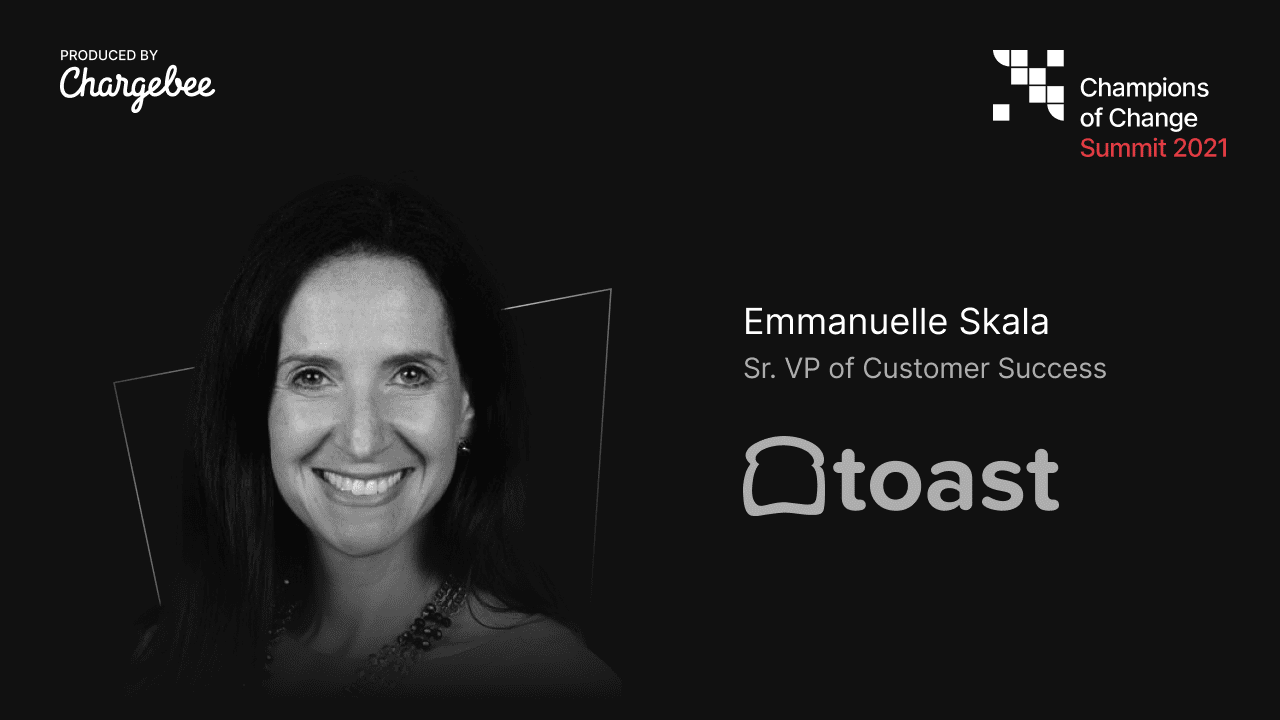In today’s fast-paced world of change, being the first to scale, not being the first mover, is what matters. Figuring out the art and science of rapidly building a global business can be pretty challenging, and the decisions you have to take can be as counter-intuitive as it comes.
Emmanuelle Skala, Senior VP of Customer Success at Toast, has been building and scaling businesses for the last 21 years. She has played a pivotal role in the growth of companies DigitalOcean, Sophos, Influitive, Endeca, and Vertica, where she has championed change at scale. In this session with Vikram Bhaskaran, Senior Director Marketing at Chargebee, she shares the secrets that help companies scale from force multipliers to understanding numbers. If you can crank up each of these axes, you can create a formidable growth engine.

Here are some of the key takeaways from the session
Have a Customer-Centric DNA
Cliche but true, all hyper-growth companies obsess about their customers. Emmanuelle says customer-centricity has to be deeply rooted in the company’s culture and must come from the founders. “The founding team needs to set the stage for what are your beliefs as it comes to customer satisfaction. What’s your true north? How are you going to run the business in a customer-centric way?” she says. And that’s how that’s just the way most successful hyper-growth companies are built from Day One. Companies like Amazon, Zoom, Slack, Hubspot, Zapier have taken the customer-centric path to achieve hyper-growth by listening to their customer needs, adapting to their changing preferences, and enabling their success.
So you need to have a customer-centric team in place early on to make sure the customer’s voice is always heard. At Toast which helps restaurants scale, Emmanuelle says they do restaurant empathy training, bringing customers for fireside chats for the whole company to hear, even highlighting the unhappy customer stories to the executive team to learn and grow from as a company. “It’s about infusing everything with training and empathy and bringing your customers to the table. You’re signaling to the company that we care about our customers and their experience, and we want to bring them in. So that’s how I’ve addressed being customer-centric at a company level,” she explains.
Invest in Force Multipliers
To scale efficiently, Emmanuelle says you need to invest in force multipliers early on. A force multiplier typically can be a role in the company, technology, or investment in tech that will force multiply the team’s impact. It could even be a sales team or a success team. Too many companies focus first on scaling their teams without investing in systems, tools, ops, and enablement to multiply their productivity. “You need to invest in force multipliers early. Many companies hire their first dedicated enablement person, maybe when they’re already at $50 million or more. It’s too late by that point,” says Emmanuelle. According to her, when you’re building out a sales team or a CS team, one of your first hires really should be for the operations role. Having them as part of your initial core team is going to help you scale the business. “You don’t want to scale linearly. Over time you want to make sure that it doesn’t cost you one rep to get every million dollars. You want to be able to get a rep and get $2 million, and you can do that by investing in technology enablement,” she says.
Focus on Customer Advocacy
Customer advocacy plays a crucial role in driving hyper-growth. But you can’t take advocacy for granted. It doesn’t happen naturally, you have to invest in it. You have to find your advocates first, understand who they are, and then nurture them. So you have to start by having a program to make sure you are listening to and optimizing the benefits that advocates are bringing you.
“The reality is that today, with so much choice that buyers have, they’re relying more on word of mouth and referrals from their peers. So you got to get that voice amplified, and having a program is pretty critical,” says Emmanuelle.
Once you have a program in place, you can start asking your advocates for referrals, reviews on review sites, answering questions on social media, being part of speaker events, or doing case studies. You have to create an environment where there’s something in it for your advocate. For instance, they can get $100 for a referral or get points if you use a platform like Influitive, “ But the best way to incentivize your advocates is to tap into their need for a voice and being elevated in their industry.
She cites Salesforce as an example of a company that has done a phenomenal job nurturing its advocates. In their early days, Salesforce ran a customer campaign to turn their early adopters or strong advocates into heroes. They would put them on stage and help them get recognition in their peer group which would elevate their careers. “It was a win-win for both, and that’s a great example of how you create advocates. Customer advocacy was a big part of Salesforce’s growth.”
Be Metrics-Driven
‘In God we trust, all others must bring data’ is pretty much the mantra of successful scale-up companies. All of them swear by their key metrics and leverage technology to make data-driven scaling decisions. “They are very driven by numbers, making sure they understand everything from your waterfall funnel to what drives the cost to what drives NPS,” says Emmanuelle. It not only gives you a clear picture of the overall business but also gives you a good indication of the areas you need to double down to achieve hyper-growth. When you’re scaling up, the sheer velocity of growth tends to pull the company in many directions, so it is crucial to invest in growth opportunities that will generate the highest ROI in the long term.
Keeping a close track of your numbers also helps a great deal when planning for the future. Emmanuelle says that it is crucial not to be tied down to a specific budget when scaling up. She recommends that companies follow the more dynamic waterfall model based on the entire customer journey when planning for sales capacity. “ I’m a big advocate on doing monthly budgets and especially with a high growth company at scale. If you follow the waterfall model, most of your resources are variable based on demand every month, not based on what you thought demand might’ve been a year ago, which is crazy.” A more dynamic resource planning model will ensure you don’t miss out on any market opportunities or compromise customer satisfaction.
Whether it is planning for resources or deciding the strategic decision the company needs to take, having analytical resources and hiring people, especially your leaders, with strong analytical skills early on is pretty critical.
Setting the Right Customer Expectations
As you’re scaling up, every customer has slightly different needs and expectations from your product, the business, and the people servicing them. So how do you ensure there is a consistent level of customer satisfaction? Emmanuelle says you need to be transparent and set expectations at every stage of the customer’s journey. “Starting with ICP and ensuring that you have enough variability in your product offering and your service offering to meet those various needs, you need to set the right expectations,” she points out. You can make the consistency problem much easier if you can hone in on your ideal customer profile, what successful customers look like, and how you market and sell to them right out of the gate. Once that is clear, incentivize your sales team to find the right-fit customers. It’s essential that the sales team also set expectations around what happens post-sale.” People want to know what’s next. They don’t want to be surprised, so explain what the customer journey will look like. When customers see you living up to that promise, that’s going to lead to trust,” says Emmanuelle
But all customers aren’t created equal. So you do want to develop various offerings. Today, most SaaS products have a good, better, best in the features and capabilities you can get. When you do the same thing with your service-level experience, then you’re setting expectations. If you signed up for good, this is what you get. If you signed up for the better, this is what you get. If you signed up for the best, this is what you get. And then, in case someone signed up for good and realizes they want the best, you can have that conversation that says this is what the best looks like, and this is how much it’s going to cost you.
Finally, everyone in the company must be thinking about customer satisfaction. “Pick whatever metric is important to you that’s the best proxy for customer satisfaction. It could be CSAT, retention or NPS, or something else and measure every leader on that. Every single leader needs to focus on how to improve customer satisfaction,” says Emmanuelle.
If you are looking for more fascinating insights from business leaders across industries, check out our Champions of Change Podcast! We’re decoding change and celebrating change makers one episode at a time, so be sure to listen and subscribe!

